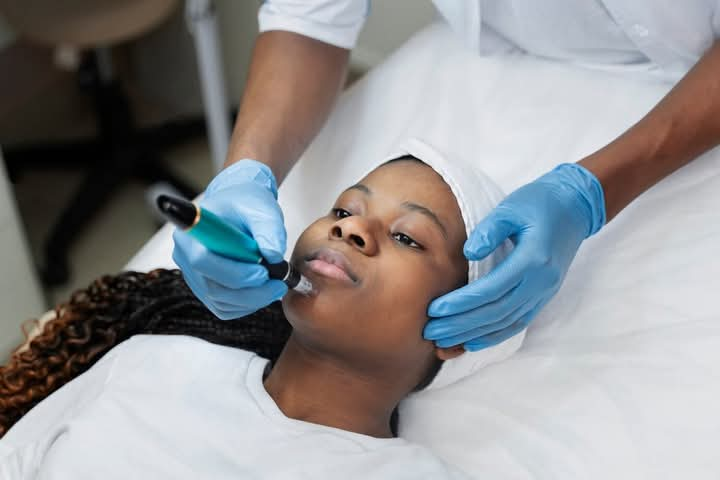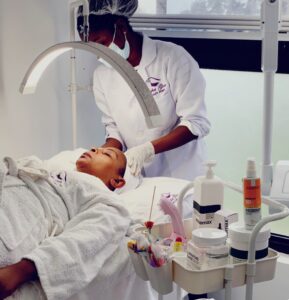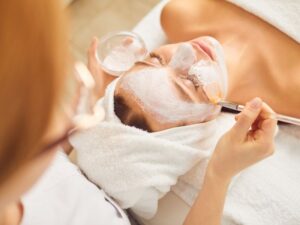Microneedling
Microneedling, a minimally invasive cosmetic procedure, has surged in popularity for its ability to address a wide range of skin concerns. From acne scars to fine lines, this technique harnesses the skin’s natural healing process to create a smoother, more youthful complexion. If you’re curious about microneedling and its potential benefits, this comprehensive guide will walk you through everything you need to know.
What is Microneedling?
Microneedling, also known as collagen induction therapy, involves using a device equipped with fine, sterile needles to create controlled micro-injuries on the skin’s surface. These tiny punctures stimulate the body’s natural wound-healing response, triggering the production of collagen and elastin, two essential proteins that provide skin with its structure and elasticity.
The depth of the needles can be adjusted depending on the specific skin concern and treatment area. This allows for customized treatments tailored to individual needs. Microneedling can be performed on various areas of the body, including the face, neck, décolletage, and scalp.
How Does Microneedling Work?
The process begins with a thorough cleansing of the skin. A topical numbing cream is typically applied to minimize discomfort during the procedure. Once the skin is numbed, the microneedling device is gently moved across the treatment area, creating thousands of microscopic punctures.
These micro-injuries initiate a cascade of biological events:
- Release of Growth Factors: The skin releases growth factors that stimulate fibroblasts, cells responsible for collagen and elastin production.
- Collagen and Elastin Synthesis: Increased fibroblast activity leads to a surge in collagen and elastin synthesis, resulting in firmer, smoother, and more youthful-looking skin.
- Angiogenesis: Microneedling also promotes angiogenesis, the formation of new blood vessels, which improves blood flow and nutrient delivery to the skin.
This controlled injury and healing process leads to skin remodeling, resulting in improved texture, reduced wrinkles, and diminished scars.
Benefits of Microneedling
Microneedling offers a multitude of benefits for various skin concerns:
1. Reducing Acne Scars
Acne scars, particularly atrophic (depressed) scars, can be significantly improved with microneedling. The controlled micro-injuries help break down scar tissue and stimulate the production of new collagen, filling in the depressions and smoothing out the skin’s surface.
2. Minimizing Fine Lines and Wrinkles
As we age, collagen and elastin production naturally declines, leading to the formation of fine lines and wrinkles. Microneedling can stimulate the production of these proteins, reducing the appearance of wrinkles and creating a more youthful complexion.
3. Improving Skin Texture and Tone
Microneedling can improve overall skin texture and tone by minimizing pores, reducing hyperpigmentation, and smoothing out rough patches. The increased collagen production results in a more even and radiant complexion.
4. Treating Hyperpigmentation
Microneedling can help reduce hyperpigmentation, such as sunspots and melasma, by breaking up melanin clusters and promoting the growth of new, evenly pigmented skin cells.
5. Stimulating Hair Growth
Microneedling can be used to stimulate hair growth by promoting blood flow and nutrient delivery to the hair follicles. It can be combined with topical hair growth treatments for enhanced results.
6. Enhancing Product Absorption
The micro-channels created during microneedling allow for better absorption of topical skincare products, such as serums and growth factors. This can enhance the efficacy of these products and accelerate skin healing.
What to Expect During and After a Microneedling Treatment
The microneedling procedure itself typically takes 30-60 minutes, depending on the treatment area. Before the procedure, a topical numbing cream is applied to minimize discomfort. During the treatment, you may feel a slight prickling or scratching sensation.
After the procedure, you may experience some redness, swelling, and mild sensitivity, similar to a sunburn. These side effects typically subside within a few days. It’s essential to follow your provider’s aftercare instructions to ensure proper healing and minimize the risk of complications.
Aftercare Tips:
- Avoid sun exposure and wear sunscreen with an SPF of 30 or higher.
- Avoid harsh skincare products and exfoliants for a few days.
- Use gentle cleansers and moisturizers.
- Avoid makeup for at least 24 hours.
- Avoid strenuous exercise and sweating for a few days.
- Follow any specific instructions given by your practitioner.
Who is a Good Candidate for Microneedling?
Microneedling is generally safe and effective for most skin types and tones. However, it’s essential to consult with a qualified skincare professional to determine if you are a good candidate.
Microneedling may not be suitable for individuals with:
- Active acne or skin infections
- Eczema or psoriasis
- Keloid scarring
- Blood clotting disorders
- Pregnancy or breastfeeding
Choosing a Qualified Provider
It’s crucial to choose a qualified and experienced skincare professional for your microneedling treatment. A licensed esthetician, dermatologist, or plastic surgeon can perform microneedling safely and effectively.
When choosing a provider, consider their:
- Experience and qualifications
- Training and certifications
- Hygiene practices
- Use of sterile equipment
- Reviews and testimonials
Microneedling at Home vs. Professional Treatments
While at-home microneedling devices are available, professional treatments offer several advantages:
- Controlled Depth: Professionals can adjust the needle depth to target specific skin concerns and treatment areas.
- Sterile Environment: Professional clinics maintain a sterile environment, minimizing the risk of infection.
- Expert Knowledge: Professionals have the expertise to assess your skin and recommend the appropriate treatment plan.
- Combination Therapies: Professionals can combine microneedling with other treatments, such as PRP or growth factors, for enhanced results.
At home devices carry greater risk of infection, or damage to the skin if used incorrectly.
Conclusion
Microneedling is a versatile and effective treatment for a wide range of skin concerns. By stimulating the skin’s natural healing process, it can improve skin texture, reduce wrinkles, and minimize scars. If you’re considering microneedling, consult with a qualified skincare professional to determine if it’s right for you. With proper care and maintenance, microneedling can help you achieve a smoother, more radiant complexion.




